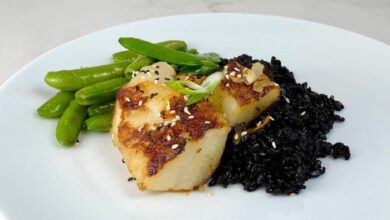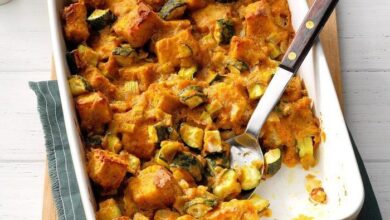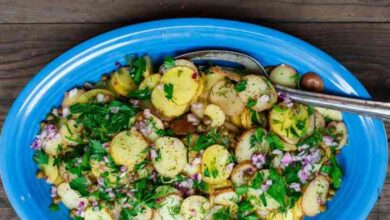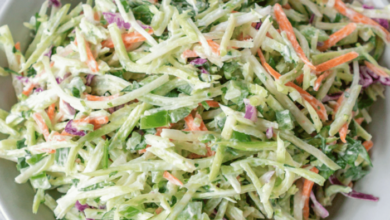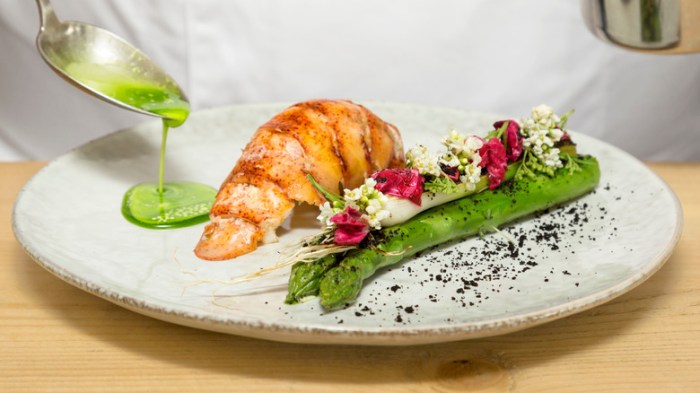
Sous Vide Butter Poached Lobster Tails: A Culinary Masterpiece
Sous vide butter poached lobster tails offer a culinary experience that’s both luxurious and surprisingly easy to achieve. This method of cooking, which involves submerging vacuum-sealed food in a precisely temperature-controlled water bath, ensures perfectly cooked lobster every time.
The gentle heat of the water bath, combined with the rich flavor of butter and aromatic herbs, creates a tender, succulent lobster that melts in your mouth.
Imagine the aroma of fresh herbs mingling with the rich buttery scent as the lobster gently simmers in the water bath. The result is a dish that’s both elegant and satisfying, perfect for a special occasion or an intimate dinner for two.
Whether you’re a seasoned chef or a home cook looking to impress, sous vide butter poached lobster tails are a recipe that’s sure to delight.
Sous Vide Butter Poached Lobster Tails
Sous vide cooking, a technique that involves precisely controlling the temperature of food while submerged in a water bath, has revolutionized the culinary world. This method ensures consistent and perfectly cooked results, allowing chefs and home cooks alike to achieve restaurant-quality dishes with ease.
For lobster tails, sous vide cooking offers a unique advantage: it gently cooks the meat to a perfect doneness, resulting in succulent, tender, and flavorful lobster that melts in your mouth.
Benefits of Sous Vide Cooking for Lobster Tails
Sous vide cooking offers several advantages for lobster tails:
- Precise Temperature Control:The constant temperature of the water bath ensures that the lobster meat cooks evenly throughout, eliminating the risk of overcooking or undercooking. This results in consistently tender and juicy lobster every time.
- Moisture Retention:By cooking the lobster in a sealed bag, sous vide prevents moisture loss, resulting in incredibly succulent and flavorful meat. This is particularly beneficial for lobster tails, which can become dry and rubbery if overcooked.
- Flavor Infusion:Sous vide cooking allows for the infusion of flavors into the lobster meat. By adding aromatics like herbs, spices, or butter to the cooking bag, you can create a complex and delicious flavor profile that complements the natural sweetness of the lobster.
Butter Poaching: A Unique and Delicious Technique
Butter poaching is a culinary technique that involves gently cooking food in a bath of melted butter. This method imparts a rich, buttery flavor and creates a tender and succulent texture. For lobster tails, butter poaching is particularly effective, as the butter melts into the meat, enhancing its natural sweetness and creating a decadent and luxurious experience.
- Flavor Enhancement:The rich, buttery flavor of the poaching liquid infuses the lobster meat, creating a decadent and indulgent experience. This is a particularly effective method for enhancing the natural sweetness of the lobster.
- Tenderness and Juiciness:The gentle heat of the butter bath ensures that the lobster meat cooks evenly and retains its moisture, resulting in a tender and juicy texture. This is a significant advantage over traditional methods of cooking lobster, which can result in dry and rubbery meat.
- Versatility:Butter poaching can be adapted to different flavor profiles by adding herbs, spices, or citrus zest to the poaching liquid. This allows for the creation of unique and delicious flavor combinations that complement the lobster meat.
Ingredients and Preparation
Sous vide butter poaching lobster tails is a simple yet elegant method for preparing this delicious crustacean. It involves immersing the lobster tails in a precisely controlled water bath, ensuring even cooking and a tender, succulent texture.
Sous vide butter poached lobster tails are a luxurious treat, but sometimes I crave something simpler and more comforting. That’s when I turn to my trusty recipe for homemade beef breakfast sausage patties. The savory, spiced sausage patties are a perfect pairing for a hearty breakfast or brunch, and they remind me of the cozy mornings I spent with my family.
After a satisfying sausage breakfast, I’m always ready to tackle the next culinary challenge, like perfecting my sous vide butter poached lobster tails.
Ingredients
The key to a successful sous vide butter poached lobster tail lies in the quality of the ingredients and the meticulous preparation.
- Lobster tails: Choose fresh, high-quality lobster tails, ideally weighing around 6-8 ounces each. Look for tails with firm, shiny shells and a bright red color. Avoid any tails that have a dull or discolored shell or a fishy odor.
- Butter: Unsalted butter is the preferred choice for poaching lobster tails. It adds a rich flavor and helps to create a luscious sauce. Use about 1/2 cup of butter per pound of lobster tails.
- Aromatics: Aromatic herbs and spices add depth and complexity to the flavor of the poached lobster tails. Some popular choices include fresh thyme, rosemary, bay leaves, garlic cloves, and black peppercorns.
- Salt: A pinch of salt is essential for seasoning the lobster tails. It enhances the natural sweetness of the meat and balances the richness of the butter.
- Lemon juice: A squeeze of fresh lemon juice adds a bright and refreshing note to the poached lobster tails. It also helps to balance the richness of the butter.
Preparing the Lobster Tails
Before poaching, it is crucial to prepare the lobster tails properly.
Sous vide butter poached lobster tails are a luxurious treat, but sometimes you want a little something extra to cut through the richness. That’s where a bright and tangy side dish comes in, like these pickled jalapenos and carrots.
The heat of the jalapenos and the sweetness of the carrots create a perfect contrast to the buttery lobster, while the pickling brine adds a refreshing acidity. It’s a combination that elevates the lobster to a whole new level of deliciousness.
- Splitting the tails: Using a sharp chef’s knife, carefully split the lobster tails lengthwise, leaving the tail meat intact. This allows for even cooking and easier penetration of the butter and aromatics.
- Cleaning the tails: After splitting, remove the intestinal tract (the dark vein running along the back of the tail meat) by gently pulling it out with a sharp knife or tweezers. Rinse the lobster tails under cold water and pat them dry with paper towels.
Sous vide butter poached lobster tails are a decadent treat, offering tender, succulent meat with a rich, buttery flavor. For a similar seafood indulgence, you can also try stuffed salmon with shrimp and crab , which combines the delicate sweetness of salmon with the briny goodness of shrimp and crab.
Both dishes are perfect for a special occasion and are sure to impress your guests. If you’re looking for a lighter alternative to lobster, consider the salmon, but for a truly luxurious experience, there’s nothing quite like a sous vide butter poached lobster tail.
- Seasoning the tails: Season the lobster tails generously with salt and pepper. For extra flavor, add a few sprigs of fresh thyme, rosemary, or bay leaves to the inside of each tail. Alternatively, you can use a combination of garlic cloves, black peppercorns, and a pinch of cayenne pepper.
The Role of Butter and Aromatics
The butter plays a crucial role in the poaching process, serving as a medium for cooking and a source of flavor. The aromatics, such as thyme, rosemary, and garlic, infuse the butter with their distinct flavors, enhancing the overall taste of the poached lobster tails.
“The butter acts as a protective barrier, preventing the lobster meat from becoming dry and tough while infusing it with its rich, creamy flavor. The aromatics add complexity and depth to the butter, creating a truly indulgent culinary experience.”
Sous Vide Cooking Process
Sous vide cooking is a precise method that involves immersing food in a temperature-controlled water bath. This technique ensures even cooking and prevents overcooking, resulting in perfectly tender and flavorful lobster tails.
Setting Up the Sous Vide Bath
Setting up the sous vide bath is a simple process that requires a few essential tools and careful temperature control.
- Choose a suitable container: Select a pot or container large enough to hold the water bath and the lobster tails. The container should be heat-resistant and have a lid to help maintain the desired temperature.
- Fill the container with water: Fill the container with enough water to cover the lobster tails by at least 2 inches. The water level should be high enough to ensure that the lobster tails are fully submerged.
- Set the temperature: The ideal temperature for sous vide cooking lobster tails is 135°F (57°C). This temperature ensures that the lobster meat cooks to a tender and juicy consistency while maintaining its delicate flavor. Adjust the temperature of the water bath using a sous vide cooker or a precision thermometer.
Sealing the Lobster Tails
To ensure even cooking and prevent the lobster tails from drying out, it’s crucial to seal them properly in vacuum bags or a suitable alternative.
- Vacuum sealing: This method is ideal for preserving the flavor and moisture of the lobster tails. Place each lobster tail in a vacuum-seal bag, ensuring that no air remains trapped inside. Seal the bag using a vacuum sealer to remove all air and create a tight seal.
- Alternative methods: If you don’t have a vacuum sealer, you can use a zipper-lock bag and displace the air by submerging the bag in water before sealing it. Another option is to use a water displacement method by placing the lobster tail in a freezer-safe bag and immersing it in a bowl of water, pushing out the air before sealing it.
Cooking Time and Temperature
The cooking time for sous vide lobster tails depends on the size of the tails. The ideal temperature for achieving optimal doneness is 135°F (57°C).
- Small lobster tails (4-6 ounces): Cook for 15-20 minutes.
- Medium lobster tails (6-8 ounces): Cook for 20-25 minutes.
- Large lobster tails (8-10 ounces): Cook for 25-30 minutes.
Butter Poaching Techniques
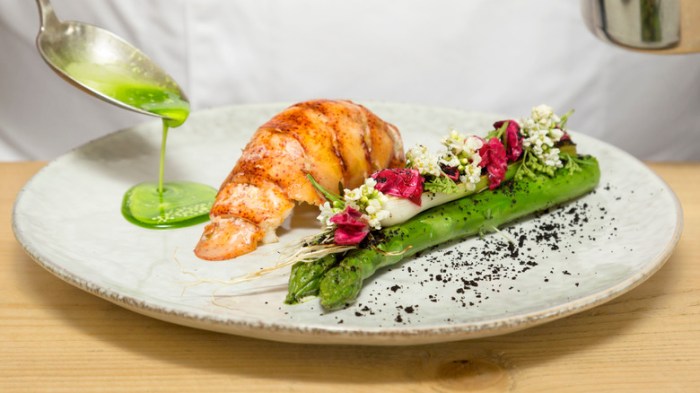
Butter poaching is a gentle cooking method that infuses the lobster tails with rich, buttery flavor while keeping the meat succulent and tender. The process involves submerging the lobster tails in a simmering butter bath, allowing the heat to penetrate the meat gradually.
This technique offers a unique flavor profile compared to traditional grilling or steaming methods.
Butter Poaching Methods
There are two primary methods for butter poaching lobster tails: using a saucepan or a Dutch oven. Both methods are effective and offer distinct advantages depending on the desired outcome and available equipment.
- Saucepan Method:This method is ideal for smaller batches of lobster tails. A saucepan provides a more controlled cooking environment, allowing for precise temperature regulation. It’s important to ensure that the saucepan is large enough to comfortably accommodate the lobster tails without overcrowding.
- Dutch Oven Method:A Dutch oven is a versatile option for larger batches of lobster tails. Its deep, wide base and tight-fitting lid create a more even heat distribution, resulting in consistent cooking throughout the lobster tails. The Dutch oven’s capacity allows for the poaching of multiple lobster tails simultaneously.
Maintaining a Gentle Simmer
Maintaining a gentle simmer throughout the poaching process is crucial for achieving optimal results. A simmering butter bath allows the heat to penetrate the lobster tails gradually, ensuring that the meat cooks evenly and remains tender. A rolling boil, on the other hand, can cause the lobster tails to toughen and the butter to separate, compromising the final flavor and texture.
The Role of Aromatics, Sous vide butter poached lobster tails
Aromatics play a significant role in enhancing the flavor of the butter poaching process. Adding herbs, spices, and other flavoring agents to the butter bath infuses the lobster tails with complex and nuanced flavors. Common aromatics used in butter poaching include:
- Garlic:Garlic adds a pungent, savory flavor that complements the lobster’s sweetness.
- Shallots:Shallots provide a subtle sweetness and a hint of onion flavor.
- Thyme:Thyme adds a herbaceous and earthy note to the butter bath.
- Bay Leaves:Bay leaves impart a warm, slightly bitter flavor.
- Lemon Zest:Lemon zest adds a bright, citrusy note that balances the richness of the butter.
Clarified Butter for a Cleaner Flavor
Clarified butter, which is butter that has been separated from its milk solids, is often preferred for butter poaching. This process removes the milk solids that can cause the butter to burn and create a cloudy, milky flavor. Using clarified butter results in a cleaner, more buttery flavor and prevents the butter from separating during the poaching process.
Serving and Presentation
Presenting sous vide butter poached lobster tails is all about highlighting their natural beauty and succulent flavor. The key is to create a visually appealing and flavorful dish that celebrates the lobster’s delicate texture and rich taste.
Serving Ideas
Lobster tails are a versatile dish that can be served in various ways, depending on the occasion and personal preference. Here are some ideas for serving sous vide butter poached lobster tails:
- Classic Presentation:Serve the lobster tails on a bed of creamy risotto, accompanied by a drizzle of melted butter and a sprinkle of fresh parsley. This classic combination showcases the lobster’s delicate flavor and creates a luxurious and elegant presentation.
- Summery Salad:For a lighter and more refreshing option, serve the lobster tails over a bed of mixed greens with cherry tomatoes, cucumbers, and a light vinaigrette. This combination is perfect for a warm summer evening.
- Spicy and Savory:Elevate the flavor profile with a spicy and savory twist. Serve the lobster tails with a side of creamy corn grits, a dollop of spicy chili butter, and a sprinkle of fresh cilantro. This combination offers a delightful contrast of flavors and textures.
Accompanying Sides
Choosing the right sides can enhance the overall dining experience. Here are some ideas for accompaniments:
- Starchy Sides:Creamy risotto, mashed potatoes, or a simple side of rice are excellent options for balancing the richness of the lobster.
- Fresh and Light:A salad with a light vinaigrette or a simple side of steamed vegetables can add freshness and balance to the dish.
- Savory and Rich:Consider adding a side of roasted vegetables, grilled asparagus, or sauteed mushrooms for a more savory and flavorful accompaniment.
Sauces and Dressings
Sauces and dressings can elevate the flavor profile of the lobster tails. Here are some ideas:
- Classic Butter Sauce:A simple melted butter sauce seasoned with lemon juice, garlic, and fresh herbs is a classic and delicious accompaniment.
- Spicy Chili Butter:Add a kick of heat with a spicy chili butter sauce. Combine melted butter with chili flakes, garlic, and a touch of lime juice.
- Creamy Lemon Sauce:For a tangy and creamy option, try a creamy lemon sauce made with heavy cream, lemon juice, and a pinch of salt and pepper.
Table Layout
Creating a visually appealing table layout can enhance the dining experience. Here are some ideas:
| Dish | Accompaniments | Presentation Tips |
|---|---|---|
| Sous Vide Butter Poached Lobster Tails | Creamy Risotto, Melted Butter, Fresh Parsley | Serve the lobster tails on a bed of risotto, drizzle with melted butter, and garnish with fresh parsley. |
| Sous Vide Butter Poached Lobster Tails | Mixed Greens Salad with Cherry Tomatoes, Cucumbers, and a Light Vinaigrette | Place the lobster tails on a bed of salad, drizzle with vinaigrette, and garnish with fresh herbs. |
| Sous Vide Butter Poached Lobster Tails | Creamy Corn Grits, Spicy Chili Butter, Fresh Cilantro | Serve the lobster tails on a bed of grits, top with a dollop of chili butter, and sprinkle with fresh cilantro. |
Variations and Enhancements: Sous Vide Butter Poached Lobster Tails
The beauty of sous vide butter poaching lobster tails lies in its versatility. While the basic recipe delivers an exceptional, tender, and flavorful lobster, it’s a starting point for a multitude of flavor combinations. You can experiment with different herbs, spices, citrus flavors, and other ingredients to create unique and exciting culinary experiences.
Flavor Variations
Adding herbs, spices, and citrus flavors can transform the simple butter poaching experience into a symphony of tastes. These additions can be incorporated directly into the butter mixture or used as a finishing touch.
- Herbs:Fresh herbs like thyme, rosemary, parsley, tarragon, and chives add depth and complexity to the butter. For a more subtle flavor, add a sprig or two of herbs to the butter during poaching. For a more pronounced flavor, finely chop the herbs and incorporate them into the butter before poaching.
- Spices:Spices like black peppercorns, bay leaves, and paprika can add warmth and spice to the lobster. Add a few peppercorns or a bay leaf to the butter during poaching, or grind black pepper over the lobster after cooking. Paprika can be added to the butter or sprinkled over the lobster before serving.
- Citrus:Citrus zest and juice can add a bright and refreshing element to the lobster. Zest lemon, lime, or orange and add it to the butter during poaching. Alternatively, you can squeeze a few drops of citrus juice over the lobster after cooking.
Ingredient Additions
Incorporating additional ingredients like garlic, shallots, and peppers can further enhance the flavor profile of the lobster. These ingredients can be added directly to the butter mixture or used to create a flavorful sauce.
- Garlic:Adding minced garlic to the butter mixture during poaching will infuse the lobster with a rich and savory flavor.
- Shallots:Sautéed shallots add a sweet and savory element to the butter. Sauté shallots in a pan with butter until softened and then add them to the butter mixture during poaching.
- Peppers:Adding a pinch of red pepper flakes or a diced jalapeno pepper to the butter mixture will add a touch of heat. For a milder flavor, add the peppers towards the end of the poaching process.
Flavorful Butter Sauce
Creating a flavorful butter sauce to top the lobster tails can elevate the dish to new heights. The sauce can be made with a variety of ingredients, including herbs, spices, citrus, and other aromatics.
- Herb Butter Sauce:Combine softened butter with chopped herbs like parsley, chives, and tarragon. Season with salt and pepper and serve over the lobster.
- Citrus Butter Sauce:Combine softened butter with lemon or lime zest and juice. Season with salt and pepper and serve over the lobster.
- Garlic Butter Sauce:Combine softened butter with minced garlic. Season with salt and pepper and serve over the lobster.
- Spicy Butter Sauce:Combine softened butter with red pepper flakes or diced jalapeno peppers. Season with salt and pepper and serve over the lobster.

